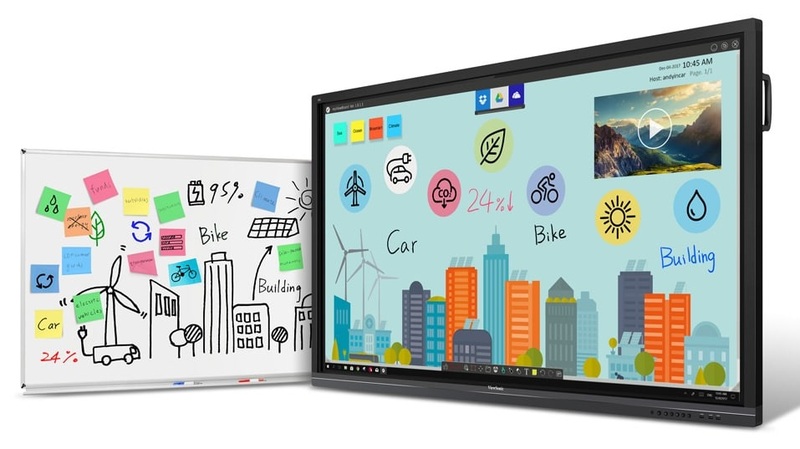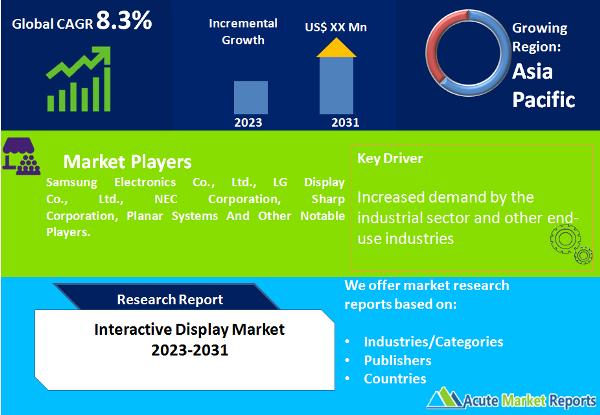
The interactive display market has experienced significant growth in recent years, driven by technological advancements, increasing adoption in various industries, and the growing demand for interactive and immersive user experiences. The global interactive display market is projected to grow at a CAGR of 8.3% during the forecast period of 2025 to 2033. Interactive displays refer to electronic displays that allow users to interact with the content through touch, gestures, or other input methods. These displays are widely used in sectors such as education, healthcare, retail, entertainment, transportation, and others. The market growth can be attributed to several factors. Firstly, the rising demand for interactive displays in educational institutions to enhance learning experiences and facilitate collaborative learning environments has been a significant driver. Interactive displays offer engaging and interactive content delivery, fostering student participation and knowledge retention. Furthermore, the healthcare sector has embraced interactive displays for applications such as telemedicine, patient engagement, digital signage, and medical training. The use of interactive displays in healthcare settings enables improved communication between patients and healthcare professionals, enhances patient education, and streamlines workflows. The market is driven by the demand for interactive and engaging content delivery, advancements in display technologies, and the need for seamless and intuitive user interfaces. As organizations and industries recognize the benefits of interactive displays in improving communication, productivity, and customer experiences, the market is expected to continue its upward trajectory in the coming years.

Increasing Demand for Enhanced User Engagement and Experience
The interactive display market is driven by the growing demand for enhanced user engagement and experience across various industries. Interactive displays offer a more immersive and interactive way for users to interact with content, leading to increased customer satisfaction and engagement. For example, in the retail sector, interactive displays enable customers to browse through products, access detailed information, and even try virtual try-ons, providing a personalized and engaging shopping experience. There has been an increasing adoption of interactive displays by major retailers such as Nike, Sephora, and IKEA, who have integrated interactive elements into their stores to create a unique and captivating shopping environment.
Advancements in Display Technologies
Advancements in display technologies have played a crucial role in driving the growth of the interactive display market. The development of touch-enabled displays, gesture recognition systems, and augmented reality (AR) technologies have expanded the possibilities for user interaction and engagement. Touch-enabled displays have become more responsive and accurate, allowing for seamless touch and gesture-based interactions. Additionally, the integration of AR technologies into interactive displays has opened up new avenues for immersive and interactive experiences. Evidence of this driver can be seen in the widespread adoption of touch-enabled interactive displays in smartphones, tablets, and interactive kiosks, as well as the increasing popularity of AR-based interactive displays in industries such as gaming, education, and tourism.
Increasing Adoption in Education and Training
The education and training sector has emerged as a significant driver for the interactive display market. Interactive displays have revolutionized classroom experiences by providing teachers with tools to create interactive and engaging lessons. These displays allow for real-time collaboration, interactive quizzes, and multimedia content delivery, fostering student participation and knowledge retention. Furthermore, interactive displays are also being utilized in corporate training environments to deliver immersive and interactive training sessions. There has been an increasing adoption of interactive displays in schools, colleges, and training institutes globally. Several studies have also highlighted the positive impact of interactive displays on student engagement, motivation, and learning outcomes, further supporting the driver's significance in the market.
High Initial Costs and Implementation Challenges
One of the key restraints in the interactive display market is the high initial costs associated with implementing interactive display solutions. The cost of acquiring and installing interactive display systems can be substantial, especially for large-scale deployments in sectors such as education and retail. The expenses include the purchase of hardware, software licenses, content development, and installation costs. For organizations with budget constraints, these upfront costs can act as a barrier to entry and hinder widespread adoption. Furthermore, there may be additional costs involved in maintaining and upgrading the interactive display systems over time. Evidence of this restraint can be seen in the challenges faced by educational institutions that struggle to allocate sufficient funds for interactive displays in classrooms. Similarly, small and medium-sized businesses in the retail sector may find it difficult to justify the high costs associated with implementing interactive displays in their stores. Additionally, there can be implementation challenges, such as the need for infrastructure upgrades, integration with existing systems, and training employees to effectively utilize interactive display technologies. These challenges can add complexity and time to the implementation process, further impeding the adoption of interactive displays.
Interactive Whiteboards Dominate the Market by Product Category
The product segment in the interactive display market encompasses various interactive display solutions, including interactive kiosks, interactive whiteboards, interactive tables, interactive video walls, and interactive monitors. Among these, interactive kiosks are expected to witness the highest CAGR during the forecast period of 2025 to 2033. Interactive kiosks find wide-ranging applications in sectors such as retail, hospitality, healthcare, transportation, and banking, offering self-service options, information dissemination, and customer engagement. The ability to provide interactive content, facilitate transactions, and gather customer data has driven the adoption of interactive kiosks across industries. In terms of the highest revenue, interactive whiteboards held a prominent position in 2024. Interactive whiteboards are extensively used in educational institutions and corporate settings for collaborative learning and interactive presentations. These interactive displays allow users to write, draw, and manipulate content on a large touch-enabled surface, enhancing collaboration and information sharing. The demand for interactive whiteboards is fueled by the increasing digitization of classrooms, the need for interactive teaching methods, and the growing popularity of remote learning. The interactive table segment also contributes significantly to the market revenue, particularly in applications such as hospitality, entertainment, and retail. Interactive tables offer a unique user experience by combining touch interactivity with a large horizontal display surface, enabling multi-user collaboration and immersive content exploration. Interactive video walls and interactive monitors are utilized in various sectors for advertising, digital signage, and interactive displays in public spaces.
Transparent panels Dominate the Market by Panel Type
The panel type segment in the interactive display market comprises flat panels, flexible panels, and transparent panels. Among these, flexible panels are anticipated to witness the highest CAGR during the forecast period of 2025 to 2033. Flexible panels offer the advantage of bendability and can be curved or rolled, allowing for unique and customizable form factors in interactive displays. These panels find applications in sectors such as consumer electronics, automotive, and advertising, where curved or flexible displays offer enhanced user experiences and design flexibility. In terms of the highest revenue, flat panels dominate the market. Flat panels are widely used in various industries, including education, healthcare, retail, and transportation. They offer excellent picture quality, durability, and versatility, making them suitable for a range of interactive display applications. Flat panels come in different sizes and resolutions, accommodating different display requirements and budgets. Transparent panels represent another significant segment in the market, contributing the highest revenue percentage in the market in 2024. Transparent panels enable interactive displays that allow users to interact with the content while still maintaining visibility through the display. These panels find applications in retail stores, museums, exhibitions, and product showcases, where the combination of interactivity and transparency creates engaging and immersive experiences. The transparent panel's segment is driven by the increasing demand for innovative display solutions that blend seamlessly with the surroundings and provide unique visual experiences. The panel type segment in the interactive display market reflects the diverse needs and preferences of various industries.
APAC to Promise Significant Opportunities during the Forecast Period
North America held the highest revenue percentage in the market in 2024, driven by the strong presence of key market players, technological advancements, and the widespread adoption of interactive display solutions across industries such as education, healthcare, and retail. The region's well-established infrastructure, high consumer disposable income, and focus on enhancing customer experiences contribute to its leading position in terms of revenue. Meanwhile, the Asia-Pacific region is expected to witness the highest CAGR during the forecast period of 2025 to 2033. The rapid economic growth, increasing investments in the education sector, and the rising adoption of interactive displays in emerging economies like China and India are propelling market growth in the region. Moreover, the growing retail sector and the implementation of digital signage and interactive kiosks in countries like Japan and South Korea are driving the demand for interactive displays. Europe also holds a significant share in the market, fueled by the adoption of interactive displays in sectors such as healthcare, transportation, and entertainment. The region's focus on improving customer engagement, the presence of major automotive manufacturers, and the promotion of digital transformation initiatives contribute to its market growth. Additionally, the Middle East and Africa region is witnessing steady growth, driven by increasing investments in sectors like retail, hospitality, and healthcare. The region's emphasis on providing innovative and engaging customer experiences, particularly in shopping malls and tourist destinations, is driving the adoption of interactive displays.
Innovation remains the Key to Enhance Market Share
The interactive display market is highly competitive and characterized by the presence of several prominent players striving to gain a significant market share. These companies continuously innovate and develop advanced interactive display solutions to cater to the diverse needs of industries such as education, healthcare, retail, and entertainment. Some of the top players in the market include Samsung Electronics Co., Ltd., LG Display Co., Ltd., NEC Corporation, Sharp Corporation, and Planar Systems (a Leyard Company). These companies employ various strategies to maintain their competitive edge in the market. One key strategy is product development and innovation. The leading players invest heavily in research and development to introduce advanced interactive display technologies, such as touch-enabled displays, gesture recognition systems, and augmented reality (AR) capabilities. They focus on enhancing the functionality, performance, and visual appeal of their products to meet evolving customer demands. Another key strategy is strategic partnerships and collaborations. Companies often form alliances with technology providers, software developers, and content creators to create integrated solutions and enhance the user experience. Such partnerships enable the seamless integration of hardware and software, offering comprehensive interactive display solutions to end-users.
Historical & Forecast Period
This study report represents analysis of each segment from 2023 to 2033 considering 2024 as the base year. Compounded Annual Growth Rate (CAGR) for each of the respective segments estimated for the forecast period of 2025 to 2033.
The current report comprises of quantitative market estimations for each micro market for every geographical region and qualitative market analysis such as micro and macro environment analysis, market trends, competitive intelligence, segment analysis, porters five force model, top winning strategies, top investment markets, emerging trends and technological analysis, case studies, strategic conclusions and recommendations and other key market insights.
Research Methodology
The complete research study was conducted in three phases, namely: secondary research, primary research, and expert panel review. key data point that enables the estimation of Interactive Display market are as follows:
Market forecast was performed through proprietary software that analyzes various qualitative and quantitative factors. Growth rate and CAGR were estimated through intensive secondary and primary research. Data triangulation across various data points provides accuracy across various analyzed market segments in the report. Application of both top down and bottom-up approach for validation of market estimation assures logical, methodical and mathematical consistency of the quantitative data.
| ATTRIBUTE | DETAILS |
|---|---|
| Research Period | 2023-2033 |
| Base Year | 2024 |
| Forecast Period | 2025-2033 |
| Historical Year | 2023 |
| Unit | USD Million |
| Segmentation | |
Product
| |
Panel Size
| |
Panel Type
| |
Vertical
| |
Technology
| |
|
Region Segment (2023-2033; US$ Million)
|
Key questions answered in this report